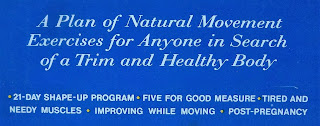Miss Craig's 21-Day Shape-Up Program For Men And Women; author Marjorie Craig, published in 1968. The dust jacket is a little beat up, but what do you want from something this old that I paid 50 cents for?
And what did I get for that 50 cents?
Sounds good, right? From reading the intro, it seemed like a solid "shape-up" program. At the time of publication, Ms. Craig, who had a phys-ed degree and a background in physical therapy, was teaching private exercise lessons at a fancy NYC salon, Elizabeth Arden's. Miss Craig was clearly no slouch, and she didn't want us to slouch either.
35 exercises make up the 21-Day Program, and these are practiced in stages, with new movements and/or increased repetitions added each day. I like this way of gradually learning a fitness routine; it's easier to get things right.
There is an element of stretching in each exercise, and I like this as well. I do a fair amount of physical work about the place, and I'm not getting any younger either. Who wants to walk around creaky and stiff? Not I! Indeed, many of Ms. Craig's exercises resemble those done in Pilates or yoga routines, although she doesn't say anything about those forms of physical fitness.
This is not to say I agree with everything Ms. Craig does say, though. For instance, this exercise:
This is called "Biking Side by Side", and its purpose is "to reduce fat on thighs, knees, calves and ankles". Since I wasn't blessed with long, slender legs, I agree with the need to reduce fat on them. But at the end of the directions, Ms. Craig adds:
"NOTE: You will get more benefit from cycling on the floor than from a real bike ride. Real biking can build bulging muscles in the legs. Your simulated ride tones muscles and helps reduce upper-thigh bulges".
This exercise is better than real bike riding? I disagree, but then again, Ms. Craig, as well-trained as she may have been, seems to shudder at the thought of women developing muscles. She's all about toning instead. Perhaps she was the product of her era; I don't think women were as likely to do weight training then as they are now.
There are several arm exercises in the book, but women are instructed to use only 3-lb dumbbells for them. Men can use the whopping 5-lb dumbbells. These weights sound very light, but then again, the workout is supposed to be done every day (a maintenance routine is to be followed after the entire program has been completed), so using heavier weights every day would be a no-no.
But I learned, somewhat to my surprise, that weights aren't always needed to engage muscles effectively. After the initial 21-Day program is completed, one has the option of adding in the "Five For Good Measure" units. These sets are for additional toning of problem areas. Of the five extra exercises shown for arms, only one uses weights, yet I could feel my arms tiring while doing this group.
Ms. Craig also advocates the use of ankle weights for some of the leg exercises, and these exercises are especially effective, I think.
But besides arms and legs, some of the other extra routines include help for posture, the fingers, and more work for those fat knees and ankles. I haven't seen many exercises in more recent fitness books that address posture, fingers, knees and ankles to the same extent. Perhaps it's assumed that workouts like running and strength training automatically take of such concerns. But as Ms. Craig explains:
"Do hands need exercise? They do. As one grows older, the joints in the fingers tend to become stiff and knotted. One reason for this is because we use the muscles that close the hand and flex the fingers more often than we use those that extend the fingers and those that separate the fingers". Makes sense to me, and as someone who uses her hands a lot, I appreciated the inclusion of exercises for them.
Even when one isn't exercising, the author advises: "...correct posture and movements ALL DAY, EVERY DAY...will help you to gain, more easily and quickly, your perfectly proportioned and healthy body that moves with grace". This proclamation, which is found in the "Improving While Moving" section, is followed by instructions on how to move the body during common, every day actions, such as picking something off the floor, reaching up to get something, getting up off of the floor getting out of bed, getting up from a chair, sitting down in a chair, and more.
There's even directions on how to go up and down stairs. After all, if your knees aren't in the proper position while going up the stairs, "...your thighs bulge, your hips stick out back and your abdomen protrudes - which isn't very pretty either". I guess not!
There's more topics I could cover, such as facial exercises, or a post-partum workout routine. I could use the former, but don't need the latter!
So as you can see, this is a book that covers a lot of ground. It may be old-time fitness, but it's still a good workout. You'll get nice stretching and toning from it. Just don't expect to develop any "bulging muscles"!



No comments:
Post a Comment